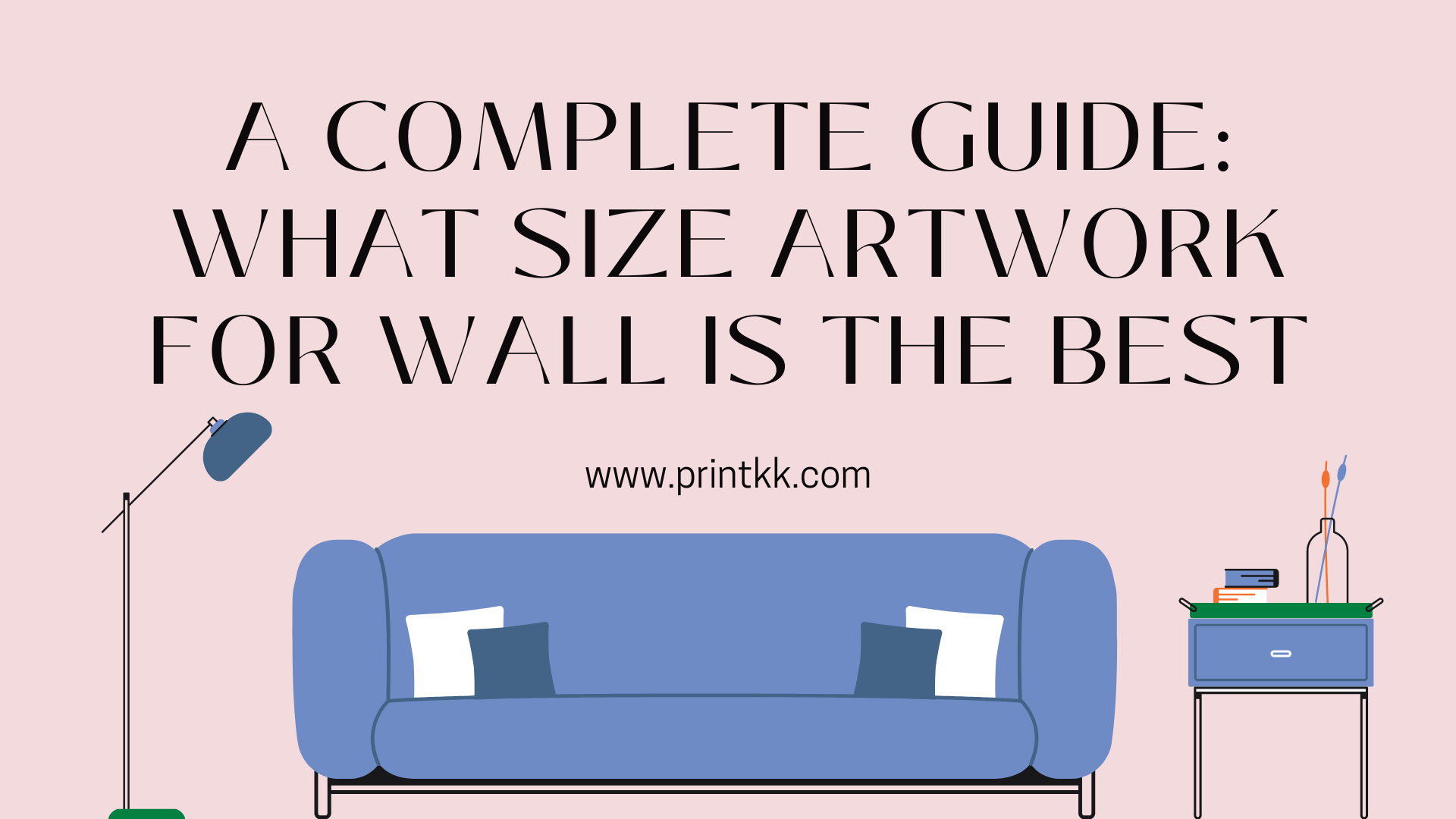
Choosing the right size artwork for your walls can dramatically transform the look and feel of a room. Whether you're decorating a cozy study or a spacious living room, the scale of wall art can influence the ambiance and aesthetic appeal of your space. This guide will help you understand the key considerations for selecting art that complements your room's dimensions and your personal style, ensuring every piece on your wall makes the perfect impact.
What Are the Common Sizes of Wall Art?
Wall art comes in a variety of sizes to suit different spaces and design preferences. Typically, smaller artworks range from 10x12 inches to about 24x36 inches. These are ideal for creating subtle accents in a room or for combining multiple pieces in a gallery wall arrangement. Smaller pieces work well in intimate spaces like bathrooms, corridors, or clustered together to create a focal point in larger rooms.
Medium-sized art generally measures between 24x36 inches to 36x48 inches. This size is versatile enough to stand alone on smaller walls or to be part of a more extensive gallery display. Medium artworks balance visibility and impact without dominating the room's decor, making them suitable for dining areas, living rooms, or bedrooms.
Large wall art can range from about 36x48 inches to 60x72 inches or more. These pieces make a dramatic statement and are typically used as a centerpiece in a room's design. Large artworks are best suited for spacious rooms with ample wall space, such as living rooms or large offices, where they can be appreciated without overwhelming the surroundings.
Why Choose the Right Size for Wall Art?
Choosing the right size for wall art is crucial for enhancing the overall aesthetic of any room. Properly scaled artwork can complement the existing decor, balance the proportions of the space, and make an impactful visual statement. For instance, a piece that is too small for a large wall can look lost and underwhelming, failing to capture the attention it might deserve.
The right size artwork helps to establish a room's ambiance. In a business setting, large, bold pieces can convey confidence and creativity, while smaller, thoughtful arrangements can create a sense of intimacy and warmth in a home environment. This strategic placement can significantly influence the room's mood and the comfort of its occupants, demonstrating the importance of size in the choice of wall art.
.jpg)
How to Choose the Size of Wall Art for Large Walls?
Choosing the right size of wall art for large walls involves understanding the scale and proportions of the space. For expansive walls, large-scale artwork can make a dramatic impact and act as a focal point. Consider pieces that are at least half the width of your furniture pieces, like a sofa or table, to create a balanced look. This ensures the art complements the existing setup without overwhelming the furniture.
In spaces such as large hallways or rooms with high ceilings, consider oversized paintings or a gallery wall arrangement. A single large piece can anchor the space, while a collection of smaller artworks can draw the eye across the area, adding visual interest and depth. When arranging multiple pieces, maintain a consistent theme or color palette for cohesion.
Think about the viewing distance. Larger rooms typically allow you to step back and appreciate large artworks from a distance. This perspective makes it easier to engage with large, detailed pieces without them feeling too imposing. The goal is to enhance the aesthetic of the space without making it feel cluttered, allowing the artwork to stand out while seamlessly integrating with the size of the wall and the room's overall decor.
How to Choose the Size of Wall Art on Narrow Walls?
Selecting the appropriate size of wall art for narrow walls requires a strategic approach. For such walls, artwork that can accentuate the vertical aspects of the area works best. Opt for tall, slender pieces that complement the height of the wall rather than its width. This draws the eye upward, making the room appear larger and more open, and avoids the cluttered feel that wider pieces might create.
When considering the placement of art on narrow walls, it's beneficial to hang pieces at eye level. This positioning engages viewers directly, making the artwork a central focus of the room without overpowering the space. Art that features vertical lines or elongated forms enhances this effect further, amplifying the perception of height and creating a more dynamic and inviting environment.
A series of smaller artworks aligned vertically can effectively utilize the available wall space. The key is to maintain a balanced spacing between each piece to ensure they read as a unified group rather than disconnected elements, preserving the harmony and flow of the room's design.
.jpg)
How to Choose the Size of the Correct Artwork to Make My Wall Look Bigger?
Choosing the right size and type of artwork to visually enlarge your wall space involves understanding a few key principles of design and perception.
Opt for large single pieces of art, which can make a wall appear more expansive. A large canvas creates an optical illusion, drawing the eye across the entire piece, thereby making the wall seem wider than it actually is. Choose art with bright colors or expansive scenes, such as landscapes, which can open up the room further.
Consider the placement of the artwork. Hanging art slightly higher than the center line of the wall can increase the sense of height and space. This technique works well with vertical pieces, enhancing the upward visual flow, which makes the ceilings appear higher, contributing to the feel of a larger room. When selecting frames, go for thin, lighter-colored frames or no frames at all to avoid visually compartmentalizing the space, which can make it appear smaller..jpg)
A Few Wall Decorating Inspirations You Should Know
Gallery Wall: A Timeless Appeal
Creating a gallery wall is an excellent way to infuse personality into any room. This arrangement involves grouping various sizes of artwork closely together to form a cohesive display. You can mix photographs, abstract prints, and even small sculptural elements to add depth.
For instance, starting with the largest piece as a focal point at the center and arranging smaller pieces around it maintains balance and attracts the eye. Use consistent framing styles or colors to unify the pieces or opt for an eclectic mix to enhance a more dynamic setup. This method allows for flexibility and growth, as you can add new pieces over time.
Large-Scale Art: Bold and Beautiful
Opting for a single large-scale piece can make a dramatic statement and serve as the room's centerpiece. Large artworks, such as a sweeping landscape or a bold abstract, draw immediate attention and set the tone for the space. When choosing a large piece, consider the wall size and room color scheme to ensure the artwork complements the environment.
For example, a minimalist black and white photograph can stand out dramatically on a brightly colored wall, providing a striking contrast that enhances both the art and the room's aesthetic..png)
Functional Art: Blend Decor with Utility
Wall art doesn't just have to be decorative; it can also be functional. Consider using beautiful wall hanging tapestry or hand-painted ceramic plates that can double as wall decor. These pieces add texture and interest to your walls while also serving a purpose.
For example, artistic wall-mounted shelving can display books and small planters, combining storage with style. Similarly, a beautifully framed chalkboard or pinboard can blend seamlessly into a kitchen or home office, offering utility while keeping with the overall decor theme. This approach not only saves space but also adds an element of surprise and creativity to functional items.
.jpg)
Conclusion
The right artwork not only complements your existing decor but also enhances the overall ambiance of your space. Whether you opt for large, statement pieces or a collection of smaller works, the key is to create a harmonious balance that reflects your style and enhances the dimensions of your room.
The decision on what size artwork to choose should align with your personal preferences and the functional dynamics of your living or working environment. Remember, artwork is an expression of your unique taste and can dramatically alter the feel of a room. You can transform any wall into a captivating focal point that elevates your interior design to new heights.
FAQs
What is the most popular wall art size?
The most popular wall art size often chosen by decorators and homeowners is the 24x36 inches. It suits a variety of settings, from living rooms to offices, complementing both modern and traditional decor.
Where should you not hang artworks?
Please avoid areas directly exposed to sunlight. It's also wise to avoid hanging artwork in narrow hallways or behind doors where it may be brushed against or knocked.
Can I customize wall art to decorate my room?
Yes, customizing wall art is a fantastic way to personalize your room and ensure it aligns perfectly with your style and decor.










 Global Shipping
Global Shipping




 Made in USA
Made in USA

























